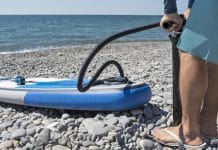Ready to take a leap into the exhilarating world of springboard diving? Look no further! In this article, we will guide you through the essential techniques, approaches, and skills that will have you gliding effortlessly into the deep end. Whether you’re a complete beginner or looking to refine your existing skills, we’ve got you covered. So, tighten those bathing caps and prepare to make a splash as we uncover the secrets of springboard diving!
Review contents
Technique
Body Position
In springboard diving, maintaining the correct body position is crucial for executing a successful dive. As athletes, we strive to achieve a straight, extended posture throughout the dive. This means keeping our body aligned from head to toe, with our arms and legs fully extended. By maintaining a tight body position, we minimize drag and increase our control over the dive. Our goal is to create a seamless, elegant line as we move through the air.
Entry
The entry is perhaps the most critical part of a dive. It is where we make the final adjustments to our body position and prepare for our descent into the water. To achieve a clean entry, we must focus on two key aspects: our body’s alignment and our entry angle. As we approach the water, we want to ensure that our body is still in a straight, extended position, allowing for a streamlined entry. Additionally, we must position ourselves in such a way that we slice through the water cleanly, minimizing any splashes or disturbances upon entry.
Takeoff
The takeoff marks the beginning of our ascent into the air and sets the stage for the dive ahead. It is crucial to generate a powerful, explosive push off the springboard to gain height and momentum. We use our legs to drive off the board, utilizing the spring-like effect to propel ourselves upward. It is vital to time our takeoff correctly, using our body’s natural rhythm and momentum to achieve optimal height and control.
Arm Movements
The movements of our arms play a significant role in our springboard diving technique. While individual preferences may vary slightly, the general purpose of our arm movements is to assist with balance, coordination, and control throughout the dive. As we take off from the springboard, our arms should be extended overhead, helping us maintain balance and providing stability. During the dive, we can use our arms to aid in rotational movements or to generate additional power and control. Ultimately, our arm movements should complement and enhance the overall execution of the dive.
Leg Movements
The coordination and control of our leg movements play a crucial role in our springboard diving performance. Proper leg positioning and technique not only contribute to our ability to gain height and power during takeoff but also influence our body’s rotation and alignment through the air. We aim to maintain our legs in a straight, extended position throughout the dive. Additionally, we utilize our legs to control our rotational movements, making adjustments as needed to achieve the desired dive trajectory. By focusing on our leg movements, we can enhance our overall performance and execute dives with precision and grace.
Approaches
Forward Approach
The forward approach is one of the fundamental techniques in springboard diving. It involves starting from a stationary position at the end of the springboard and walking forward before executing the dive. This approach allows us to gain momentum and prepare for a smooth takeoff. As we walk forward, we focus on maintaining a steady rhythm and foot placement while building up speed. By mastering the forward approach, we can establish a strong foundation for executing various dive types successfully.
Backward Approach
The backward approach, contrary to the forward approach, involves starting from the edge of the springboard facing away from the water. It requires us to walk backward before initiating the dive. This approach enables us to generate momentum and utilize the springboard’s energy effectively. While moving backward, we focus on maintaining our balance and foot placement, ensuring a seamless transition into the takeoff. The backward approach offers versatility and allows us to perform dives with different complexity and techniques confidently.
Reverse Approach
The reverse approach is an advanced technique that adds an element of complexity to our springboard diving routine. It involves starting at the end of the springboard facing the water and already in motion, moving backward before executing the dive. This approach demands exceptional coordination and timing as we need to synchronize our momentum, body position, and takeoff to execute the dive successfully. The reverse approach adds an exciting challenge to our repertoire, showcasing our skill and mastery of the sport.
Skills
Inward Dive
The inward dive is an essential skill in springboard diving that requires us to rotate our body inward towards the springboard during the dive. It is an advanced technique that showcases our control, coordination, and body awareness. To execute an inward dive effectively, we must focus on our positioning and body alignment during the takeoff and in-flight. Additionally, maintaining a tight body position and precise arm and leg movements allow us to achieve the desired rotation and entry into the water.
Forward Dive
The forward dive is one of the foundational skills in springboard diving, often the first dive beginners learn. It involves diving straight forward from the springboard, positioning our body in a straight line throughout the dive. Proper body alignment, arm movements, and takeoff contribute to a clean and graceful forward dive. By gradually building skill and technique, we can execute the forward dive with precision and confidence, eventually leading to more complex dive variations.
Backward Dive
The backward dive challenges us to rotate backward away from the springboard while maintaining control and precise body alignment. It requires us to overcome the instinctive fear of falling backward, making it an important skill for divers to develop. By practicing proper takeoff technique, body positioning, and rotational control, we can perform backward dives confidently and elegantly. This dive allows us to demonstrate our ability to control our body while in a challenging orientation, showcasing our mastery of the sport.
Reverse Dive
The reverse dive is a skill that involves rotating backward towards the springboard before extending our body and entering the water. It requires exceptional coordination, timing, and body control. By mastering the reverse approach and understanding the mechanics of the dive, we can execute reverse dives with precision and grace. Advanced divers often incorporate variations, such as multiple somersaults or twists, into their reverse dives to showcase their skill and artistry.
Twisting Dive
The twisting dive combines the elements of rotation and body control, challenging us to execute twists while maintaining proper body alignment and entry form. Twisting dives can range from simpler single-twist dives to more complex combinations of twisting movements. By focusing on our timing, technique, and body position during the dive, we can achieve clean and controlled twists, showcasing our strength, flexibility, and mastery of this skill.
Springboard diving encompasses a range of techniques, approaches, and skills that require dedication, practice, and precision. By focusing on body position, takeoff, arm movements, leg movements, and precise execution of various approaches and skills, we can excel in this dynamic and captivating sport. Through consistent training and a friendly spirit, we can continue to improve as divers, pushing ourselves to achieve new heights and execute dives with grace and skill.































